
The pipits are a cosmopolitan genus, Anthus, of small passerine birds with medium to long tails. Along with the wagtails and longclaws, the pipits make up the family Motacillidae. The genus is widespread, occurring across most of the world, except the driest deserts, rainforest and the mainland of Antarctica.

The tawny pipit is a medium-large passerine bird which breeds in much of the central Palearctic from northwest Africa and Portugal to Central Siberia and on to Inner Mongolia. It is a migrant moving in winter to tropical Africa and the Indian Subcontinent. The scientific name is from Latin. Anthus is the name for a small bird of grasslands, and the specific campestris means "of the fields".

The red-throated pipit is a small passerine bird,which breeds in the far north of Europe and the Palearctic, with a foothold in northern Alaska. It is a long-distance migrant, moving in winter to Africa, South and East Asia and the West Coast United States. It is a vagrant to Western Europe.

The olive-backed pipit is a small passerine bird of the pipit (Anthus) genus, which breeds across southern, north central and eastern Asia, as well as in the north-eastern European Russia. It is a long-distance migrant moving in winter to southern Asia and Indonesia. Sometimes it is also called Indian pipit or Hodgson's pipit, as well as tree pipit owing to its resemblance with the tree pipit. However, its back is more olive-toned and less streaked than that species, and its head pattern is different with a better-marked supercilium.

The plain-backed pipit or plain pipit is a medium-sized passerine bird which is a resident breeder in Africa south of the Sahara Desert.

The long-billed pipit or brown rock pipit is a passerine bird which has a wide distribution. A number of subspecies have been created for the populations in Africa, through the Arabian peninsula and South Asia. The systematics of this complex is yet to be clarified. Most birds are residents or short distance migrants.

Sprague's pipit is a small songbird (passerine) in the family Motacillidae that breeds in the short- and mixed-grass prairies of North America. Migratory, it spends the winters in the southwestern United States and northern Mexico. Sprague's pipits are unusual among songbirds in that they sing high in the sky, somewhat like a goldfinch or skylark. It is more often identified by its distinctive descending song heard from above than by being seen on the ground. Males and females are cryptically coloured and similar in appearance; they are a buffy brown with darker streaking, slender bills and pinkish to yellow legs. Sprague's pipit summer habitat is primarily native grasslands in the north central prairies of the United States and Canada. The species was named after the botanical illustrator Isaac Sprague.

The Nilgiri pipit is a distinctive species of pipit that is endemic to the high altitude hills of southern India. Richer brown in colour than other pipits in the region, it is distinctive in having the streaking on the breast continuing along the flanks. It is non-migratory and has a tendency to fly into low trees when disturbed and is closely related to the tree pipits Anthus hodgsoni and Anthus trivialis.

The South Georgia pipit is a sparrow-sized bird only found on the South Georgia archipelago off the Antarctic Peninsula. It is the only songbird in Antarctica, South Georgia's only passerine, and one of the few non-seabirds of the region.
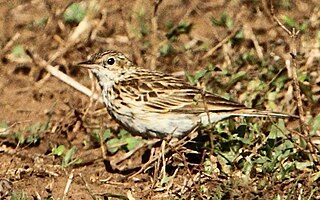
The bushveld pipit, also known as bush pipit or little pipit, is a species of bird in the pipit and wagtail family Motacillidae. It is found in Angola, Botswana, Eswatini, Ethiopia, Kenya, Malawi, Mozambique, South Africa, Tanzania, Zambia, and Zimbabwe. Its natural habitats are subtropical or tropical dry forests and dry savanna.
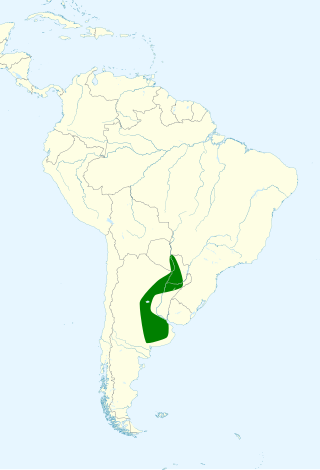
The Pampas pipit, also known as the Chaco pipit or Campo pipit, is a species of bird in the family Motacillidae. It is found in Argentina and Paraguay. Its natural habitat is temperate grassland.
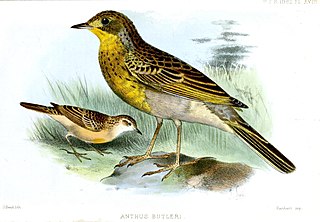
The yellow-breasted pipit is a species of bird in the pipit and wagtail family Motacillidae. It is found in Lesotho and South Africa. Its natural habitats are subtropical or tropical high-altitude grassland, arable land, and pastureland. It is threatened by habitat loss.

The correndera pipit is a species of bird in the family Motacillidae. It is found in Argentina, Bolivia, southern Brazil, Chile, the Falkland Islands, Paraguay, Peru, and Uruguay. Its natural habitats are temperate grassland, subtropical or tropical high-altitude grassland, and pastureland.

The short-billed pipit is a species of bird in the family Motacillidae.

The alpine pipit is a species of bird in the family Motacillidae. It is found in New Guinea.

The mountain pipit is a species of bird in the family Motacillidae.
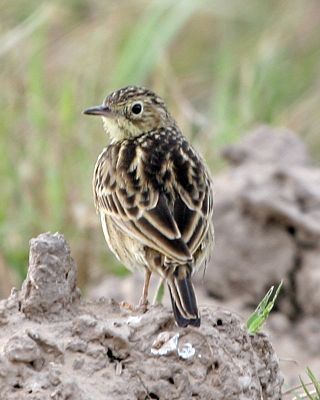
The yellowish pipit is a species of bird in the family Motacillidae. It is found in Argentina, Bolivia, Brazil, Chile, Colombia, French Guiana, Guyana, Panama, Paraguay, Peru, Suriname, Uruguay, and Venezuela. Its natural habitats are temperate grassland, subtropical or tropical seasonally wet or flooded lowland grassland, and pastureland.
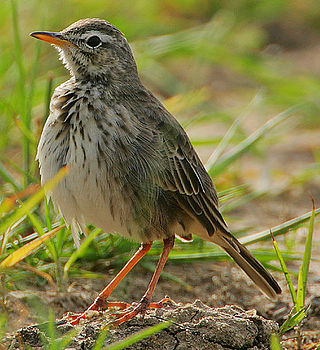
The Malindi pipit is a species of bird in the family Motacillidae. It is found in Kenya and Somalia. Its natural habitats are subtropical or tropical dry lowland grassland and subtropical or tropical seasonally wet or flooded lowland grassland. It is threatened by habitat loss.
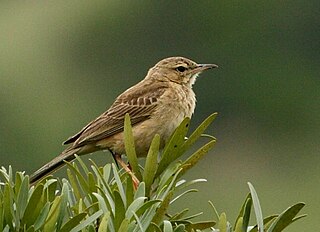
The buffy pipit is a species of bird in the Motacillidae family. It is found in plains and open countryside in southern and eastern Africa. The IUCN has assessed its conservation status as being of least concern.

The madanga or rufous-throated white-eye is a species of bird that was formerly included in the family Zosteropidae but is now thought to be an atypical member of the family Motacillidae, consisting of the pipits and wagtails. Its close relatives are tree pipits of the genus Anthus, and is endemic to the moist, mountainous, subtropical and tropical forest of the Indonesian island Buru. The bird was initially described from four specimens collected in April 1922 from one area in the western part of the island, near the settlement Wa Fehat, at elevations between 820 m (2,690 ft) and 1,500 m (4,900 ft). These observations were reproduced on two birds in December 1995 at Wakeika, at an elevation of 1,460 m (4,790 ft); changes in the bird's habitat at Wa Fehat were also noted in 1995. The bird was observed only in a few localities and neither its habitat area nor population is reliably known. The population is estimated at more than several hundred individuals, and the habitat at several hundred km2 from the available area above 1,200 m (872 km²) and above 1,500 m (382 km²); the birds are believed to disperse over their habitat rather than form groups. Because the species is restricted to a single island and its habitat is threatened by logging and other human activities, it is listed as endangered by the IUCN since 1996.




















